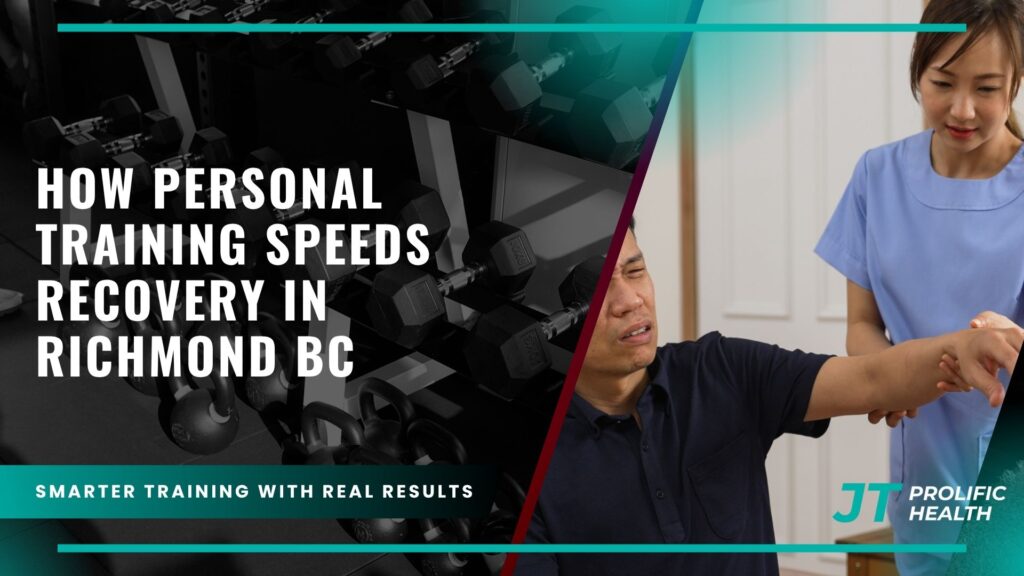Recovery from injury, surgery, or intense physical activity can be a frustrating and lengthy process that leaves many people feeling discouraged and uncertain about their path back to full health. In Richmond BC, personal training has emerged as a powerful catalyst for accelerated recovery, offering individuals a structured, professional approach to healing that goes far beyond what traditional rest-and-wait methods can provide. The science-backed techniques and personalized attention that qualified personal trainers bring to the recovery process can dramatically reduce healing time while ensuring that clients return to their activities stronger and more resilient than before.
The traditional approach to recovery often involves extended periods of rest, followed by a gradual return to normal activities without professional guidance. While rest is certainly important, this passive approach frequently leads to muscle atrophy, decreased cardiovascular fitness, compensation patterns, and psychological barriers that can actually slow the healing process. Personal training offers a revolutionary alternative by introducing controlled, progressive movement and exercise protocols that work with the body’s natural healing mechanisms rather than against them.
What makes personal training particularly effective for recovery in Richmond BC is the combination of local expertise, access to state-of-the-art facilities, and trainers who understand the unique lifestyle and activity demands of the Lower Mainland population. Whether someone is recovering from a sports injury sustained on the local hiking trails, dealing with workplace-related repetitive strain injuries common in the tech industry, or rehabilitating after surgery, personal trainers in Richmond have developed specialized protocols that address these specific recovery needs.
The acceleration of recovery through personal training isn’t just about getting back to where you were before – it’s about emerging from the recovery process stronger, more aware of your body’s capabilities and limitations, and equipped with the knowledge and habits necessary to prevent future injuries. This comprehensive approach to healing recognizes that true recovery involves not just the repair of damaged tissues, but the optimization of overall physical function and the development of movement patterns that support long-term health and performance.
Key Takeaways
For additional context, see this comprehensive guide.
- Accelerated Tissue Healing: Personal training promotes faster recovery through controlled movement that increases blood flow to injured areas, delivering essential nutrients and oxygen while removing metabolic waste products that can impede healing.
- Prevention of Muscle Atrophy: Strategic exercise protocols maintain muscle mass and strength during recovery periods, preventing the significant losses that typically occur during extended rest periods and reducing the time needed to return to pre-injury fitness levels.
- Improved Movement Quality: Professional trainers identify and correct compensation patterns that develop during injury, ensuring that recovery includes the restoration of proper movement mechanics rather than the reinforcement of dysfunctional patterns.
- Psychological Benefits: The structured, goal-oriented approach of personal training provides psychological support during recovery, maintaining motivation and confidence while reducing the anxiety and depression often associated with injury and extended recovery periods.
- Customized Recovery Protocols: Personal trainers develop individualized programs that account for the specific nature of each injury, the client’s overall health status, lifestyle demands, and recovery goals, ensuring optimal healing conditions.
- Professional Monitoring: Continuous assessment and program adjustments ensure that recovery progresses safely and efficiently, with trainers able to recognize signs of overexertion or setbacks before they become problematic.
- Long-term Injury Prevention: Recovery-focused personal training addresses underlying weaknesses and imbalances that may have contributed to the original injury, creating a stronger foundation for future activity and reducing re-injury risk.
The Science Behind Accelerated Recovery Through Personal Training

For additional context, see detailed information on this topic.
The human body’s ability to heal and adapt is remarkable, but this natural process can be significantly enhanced through the strategic application of exercise science principles that personal trainers are uniquely qualified to implement. Understanding how personal training speeds recovery requires examining the physiological mechanisms that drive healing and how targeted exercise interventions can optimize these processes.
At the cellular level, controlled movement and exercise stimulate the production of growth factors and cytokines that promote tissue repair and regeneration. When personal trainers design recovery-focused exercise programs, they’re essentially creating conditions that maximize the body’s natural healing responses while minimizing factors that could impede recovery. This includes managing inflammation levels, promoting optimal circulation, and ensuring that healing tissues receive appropriate mechanical stimulation to encourage proper fiber alignment and strength development.
The concept of progressive overload, fundamental to all effective training programs, takes on special significance in recovery contexts. Personal trainers skilled in recovery protocols understand how to apply just enough stress to stimulate healing and adaptation without overwhelming damaged tissues or triggering inflammatory responses that could set back the recovery process. This delicate balance requires extensive knowledge of exercise physiology, injury mechanisms, and individual response patterns that only qualified professionals possess.
Blood flow optimization represents another critical mechanism through which personal training accelerates recovery. Targeted exercises increase circulation to injured areas, delivering oxygen, nutrients, and immune cells necessary for tissue repair while facilitating the removal of metabolic waste products and inflammatory byproducts that can impede healing. Personal trainers design specific movement patterns and exercise sequences that maximize these circulatory benefits while respecting the limitations imposed by injury or surgical sites.
Customized Recovery Protocols for Different Injury Types


The effectiveness of personal training in speeding recovery lies largely in the ability to develop highly customized protocols that address the specific demands and limitations of different injury types. Unlike generic rehabilitation programs, personal trainers in Richmond BC create individualized approaches that consider not only the nature and severity of the injury but also the client’s overall health status, fitness level, lifestyle demands, and specific recovery goals.
For orthopedic injuries such as sprains, strains, and fractures, personal trainers employ progressive loading strategies that begin with pain-free range of motion exercises and gradually advance through strength, power, and functional movement phases. These protocols are designed to stimulate bone remodeling, promote optimal scar tissue formation, and restore normal movement patterns while preventing the development of compensation strategies that could lead to secondary injuries. The key is understanding how different tissues heal and adapting exercise parameters accordingly.
Post-surgical recovery presents unique challenges that require specialized knowledge of surgical procedures, healing timelines, and post-operative precautions. Personal trainers working with post-surgical clients must coordinate closely with medical teams to ensure that exercise interventions support rather than compromise surgical outcomes. This might involve avoiding certain movement patterns during initial healing phases while introducing others that promote circulation and prevent complications such as blood clots or excessive scar tissue formation.
Soft tissue injuries, including muscle strains and ligament sprains, benefit from carefully orchestrated movement progressions that respect the healing phases of these tissues while promoting optimal recovery outcomes. Personal trainers understand how to distinguish between different grades of soft tissue injury and modify exercise protocols accordingly, ensuring that healing tissues receive appropriate stimulation without being overwhelmed by excessive demands.
Chronic pain conditions and overuse injuries require a different approach entirely, often focusing on movement re-education, postural correction, and the gradual introduction of activities that may have become painful or problematic. These situations frequently involve complex interactions between physical limitations, pain responses, and psychological factors that skilled personal trainers are trained to navigate. For those seeking guidance on evaluating trainer qualifications for specialized recovery work, understanding these competencies becomes crucial for successful outcomes.
Movement Re-education and Compensation Pattern Correction


One of the most significant ways personal training accelerates recovery is through the systematic identification and correction of movement compensation patterns that develop during injury and can persist long after tissues have healed. These compensatory movements, while initially protective, can become deeply ingrained habits that not only slow recovery but also increase the risk of future injuries if left unaddressed.
When the body experiences injury or pain, it naturally seeks alternative movement strategies to avoid discomfort and protect damaged structures. While this protective response serves an important purpose during acute injury phases, these altered movement patterns can quickly become problematic if they persist beyond the initial healing period. Personal trainers specializing in recovery work are trained to recognize these compensation patterns and develop targeted interventions to restore optimal movement quality.
The process of movement re-education begins with comprehensive movement assessments that identify not only obvious compensations but also subtle alterations in movement timing, coordination, and muscle activation patterns. Personal trainers use various assessment tools and techniques to evaluate how clients move through fundamental patterns such as squatting, lunging, reaching, and walking, looking for asymmetries, restrictions, or inefficiencies that could impede recovery or predispose to future problems.
Corrective exercise strategies employed by skilled personal trainers often involve a systematic progression from basic movement awareness and control exercises to more complex, functional movement patterns. This might include targeted mobility work to address restrictions, stability exercises to improve motor control, and integration exercises that help clients learn to move efficiently under various conditions and demands. The goal is not just to eliminate compensation patterns but to establish new, optimal movement habits that support long-term health and performance.
The neuroplasticity of the human nervous system plays a crucial role in this re-education process. Personal trainers understand how to leverage the brain’s ability to form new neural pathways and movement patterns through repetitive, purposeful practice. This involves not just physical exercises but also cognitive strategies that help clients become more aware of their movement patterns and actively participate in the correction process. Understanding how skill acquisition principles apply to movement re-education can provide valuable insights into this complex process.
Psychological Benefits and Motivation During Recovery
The psychological aspects of recovery are often underestimated, yet they play a crucial role in determining both the speed and completeness of healing. Personal training provides significant psychological benefits that can dramatically accelerate recovery by addressing the mental and emotional challenges that often accompany injury, surgery, or extended periods of reduced activity. The support, structure, and positive reinforcement that personal trainers provide can be just as important as the physical interventions they implement.
Injury and recovery periods frequently trigger feelings of frustration, anxiety, depression, and loss of identity, particularly for individuals who are accustomed to being active or whose injuries affect their ability to work or participate in valued activities. Personal trainers serve as both coaches and counselors during these challenging times, providing emotional support while helping clients maintain a positive outlook and realistic expectations about their recovery process.
The goal-oriented nature of personal training provides structure and purpose during recovery periods that might otherwise feel directionless and discouraging. Personal trainers help clients set realistic, achievable milestones that provide regular opportunities for success and positive reinforcement. This systematic approach to goal-setting and achievement helps maintain motivation and provides tangible evidence of progress, even when improvements might be subtle or gradual.
Fear of re-injury represents one of the most significant psychological barriers to complete recovery, often persisting long after physical healing has occurred. Personal trainers are skilled at helping clients gradually rebuild confidence in their bodies through carefully progressive exercise programs that challenge them appropriately while maintaining safety. This systematic exposure to increasing levels of activity helps desensitize fear responses and rebuild the confidence necessary for full return to desired activities.
The social support aspect of personal training cannot be overlooked, particularly for individuals who may feel isolated during recovery periods. The regular interaction with a knowledgeable, supportive professional provides social connection and accountability that can be crucial for maintaining motivation and adherence to recovery protocols. Many clients find that working with a personal trainer significantly boosts their overall confidence during challenging recovery periods.
Personal trainers also play an important educational role, helping clients understand their injuries, the recovery process, and what they can expect at different stages of healing. This knowledge helps reduce anxiety and uncertainty while empowering clients to take an active role in their recovery. Understanding what’s happening in their bodies and why certain exercises or restrictions are necessary helps clients feel more in control of their situation and more committed to following recovery protocols.
Technology and Advanced Recovery Techniques
Modern personal training incorporates sophisticated technologies and advanced recovery techniques that can significantly accelerate healing and optimize recovery outcomes. Richmond BC personal trainers increasingly utilize cutting-edge tools and methodologies that were once available only in clinical or elite athletic settings, making advanced recovery techniques accessible to a broader population of individuals seeking to optimize their healing process.
Movement analysis technology allows personal trainers to objectively assess movement quality and track improvements over time with unprecedented precision. High-speed cameras, force plates, and wearable sensors provide detailed information about movement patterns, muscle activation, and biomechanical efficiency that can inform exercise prescription and monitor progress. This technology enables trainers to identify subtle movement dysfunctions that might not be apparent through visual observation alone and track improvements with scientific accuracy.
Recovery monitoring devices, including heart rate variability monitors, sleep trackers, and inflammation markers, provide valuable insights into the body’s recovery status and readiness for increased training loads. Personal trainers skilled in interpreting this data can adjust exercise programs in real-time based on objective indicators of recovery, ensuring that clients are challenged optimally without risking setbacks or overexertion.
Advanced therapeutic modalities such as pneumatic compression devices, electrical stimulation units, and infrared therapy tools are increasingly incorporated into personal training sessions to enhance recovery between exercise sessions. These technologies can accelerate tissue healing, reduce inflammation, and improve circulation, complementing the benefits of exercise-based interventions.
Virtual reality and biofeedback systems are emerging as powerful tools for movement re-education and pain management during recovery. These technologies can provide immersive, engaging experiences that help clients learn new movement patterns while potentially reducing pain perception and improving motivation. The gamification aspects of these technologies can be particularly beneficial for maintaining engagement during long recovery periods.
Nutritional optimization through advanced testing and personalized supplementation protocols represents another area where technology is enhancing recovery outcomes. Personal trainers increasingly work with registered dietitians and use advanced testing methods to identify nutritional deficiencies or imbalances that might be impeding recovery, developing targeted interventions to optimize the nutritional environment for healing.
Prolific Health: Leading Recovery-Focused Personal Training in Richmond BC
Prolific Health has established itself as a premier destination for recovery-focused personal training in Richmond BC, combining evidence-based exercise science with compassionate, individualized care to help clients achieve optimal recovery outcomes. Their team of highly qualified personal trainers specializes in working with individuals recovering from various injuries, surgeries, and health challenges, providing the expertise and support necessary to accelerate healing while ensuring safety throughout the recovery process.
What sets Prolific Health apart is their comprehensive approach to recovery that addresses not only the physical aspects of healing but also the psychological, nutritional, and lifestyle factors that influence recovery outcomes. Their trainers are extensively trained in injury-specific exercise protocols, movement assessment techniques, and the latest recovery technologies, ensuring that clients receive the most advanced and effective interventions available.
The facility at Prolific Health is specifically designed to support recovery-focused training, featuring specialized equipment for rehabilitation exercises, movement analysis technology, and therapeutic modalities that enhance the recovery process. This comprehensive setup allows their trainers to provide seamless, integrated care that addresses all aspects of the recovery journey under one roof.
Prolific Health’s commitment to continuing education ensures that their trainers stay current with the latest developments in recovery science and techniques. They regularly participate in advanced training programs, workshops, and conferences to continuously improve their ability to serve clients with diverse recovery needs. This dedication to professional development translates into better outcomes for clients and more efficient recovery processes.
The success stories emerging from Prolific Health demonstrate the effectiveness of their recovery-focused approach, with clients consistently achieving faster return to activity, improved function beyond pre-injury levels, and reduced risk of future injuries. Their systematic approach to recovery, combined with their commitment to individualized care, makes them an ideal choice for anyone seeking to optimize their healing process through professional personal training guidance.
Frequently Asked Questions
How soon after injury can I start personal training for recovery?
The timing depends on the specific injury and medical clearance from healthcare providers. Generally, some form of movement-based intervention can begin within days of injury, even if it’s just gentle range of motion exercises. Personal trainers work closely with medical teams to ensure appropriate timing and progression of exercise interventions.
Will personal training during recovery be painful?
Properly designed recovery programs should not cause significant pain. Personal trainers are trained to work within pain-free ranges and gradually progress intensity as healing occurs. Some mild discomfort during stretching or strengthening exercises may be normal, but sharp or severe pain indicates the need for program modification.
How does personal training compare to physical therapy for recovery?
Personal training and physical therapy can be complementary approaches. Physical therapy typically focuses on restoring basic function and addressing specific impairments, while personal training can bridge the gap between therapy and return to full activity. Many clients benefit from both approaches at different stages of recovery.
What qualifications should I look for in a recovery-focused personal trainer?
Look for trainers with specialized certifications in corrective exercise, injury prevention, or post-rehabilitation training. Experience working with similar injuries and strong communication skills are also important. For detailed guidance on essential trainer qualifications and certifications, professional credentials are crucial for safe, effective recovery work.
How long does recovery-focused personal training typically take?
Recovery timelines vary greatly depending on injury severity, individual factors, and recovery goals. Some clients see significant improvements within weeks, while others may require months of progressive training. Personal trainers develop realistic timelines based on individual circumstances and adjust expectations as recovery progresses.
Can personal training help prevent re-injury?
Yes, one of the primary benefits of recovery-focused personal training is injury prevention. By addressing underlying weaknesses, movement dysfunctions, and risk factors that contributed to the original injury, personal trainers help clients return to activity stronger and more resilient than before.
What should I expect during my first recovery-focused training session?
Initial sessions typically involve comprehensive assessments of movement quality, strength, flexibility, and functional capacity. Trainers will review medical history, discuss goals and concerns, and begin developing an individualized recovery program. Early sessions focus on establishing baseline function and beginning gentle, progressive exercises.
How do I know if my recovery program is working effectively?
Effective recovery programs produce gradual improvements in pain levels, range of motion, strength, and functional capacity. Personal trainers use various assessment tools to track progress objectively and adjust programs based on response to interventions. Regular communication about symptoms and function helps ensure optimal progression.
Conclusion
Personal training represents a revolutionary approach to recovery that can dramatically accelerate healing while ensuring optimal long-term outcomes for individuals dealing with injuries, surgeries, or other health challenges. The combination of evidence-based exercise science, individualized program design, and professional guidance creates an environment where the body’s natural healing processes can be optimized and enhanced through strategic interventions.
The benefits of recovery-focused personal training extend far beyond simply returning to pre-injury status. Clients who engage in professionally guided recovery programs often emerge stronger, more resilient, and better equipped to prevent future injuries than they were before their initial setback. This transformative potential makes personal training an invaluable investment in both immediate recovery and long-term health and performance.
For residents of Richmond BC seeking to optimize their recovery process, the availability of qualified personal trainers who specialize in recovery-focused interventions provides an unprecedented opportunity to accelerate healing while building a foundation for sustained health and activity. The integration of advanced technologies, evidence-based techniques, and compassionate care creates an ideal environment for achieving optimal recovery outcomes.
Whether recovering from a sports injury, post-surgical rehabilitation, or chronic condition management, personal training offers a path to faster, more complete recovery that addresses not only the physical aspects of healing but also the psychological and lifestyle factors that influence long-term success. For those considering this approach, understanding what comprehensive lifestyle modifications might be recommended can help set realistic expectations and maximize recovery potential. The investment in professional guidance during recovery periods can yield dividends in improved health, function, and quality of life that extend far beyond the immediate healing process.




